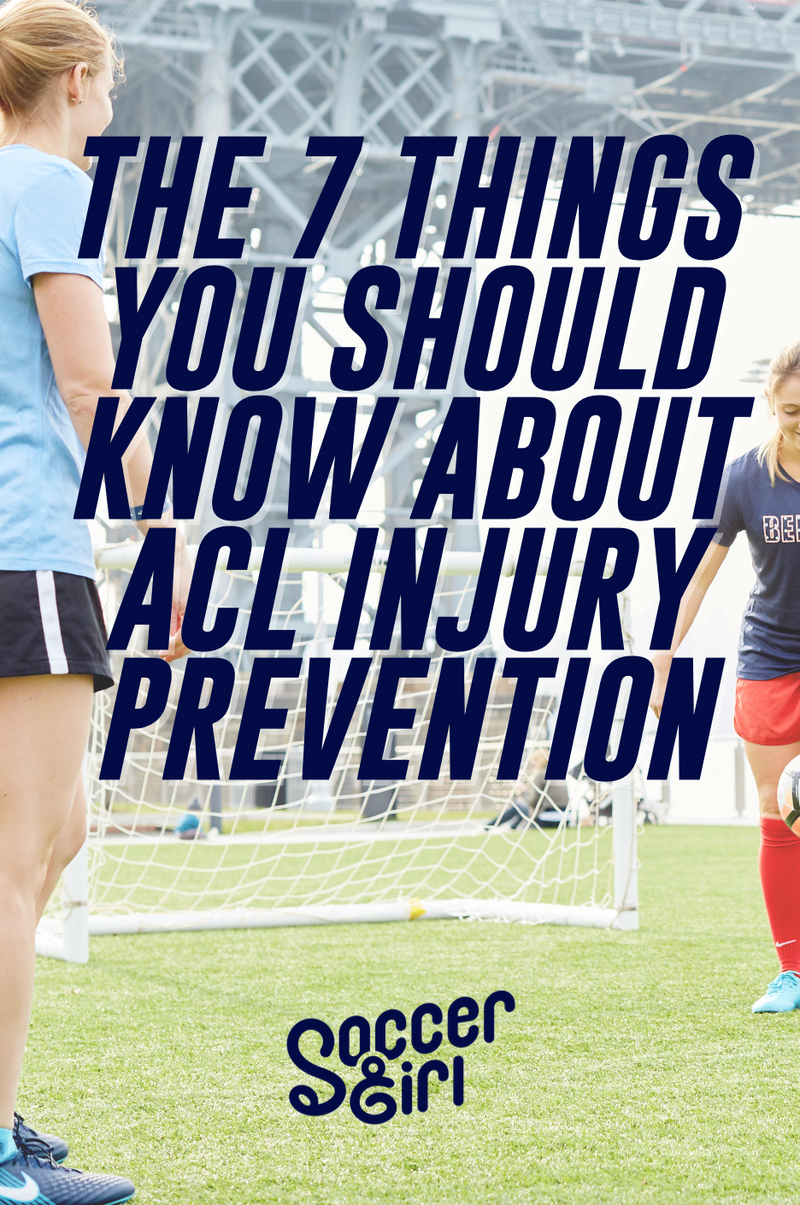
The Seven Things You Should Know About ACL injury Prevention
By An ACL Coach!
Kate Sneddon
PT, DPT, CSCS

Why do ACL injuries happen?
This is the biggest question I get—and honestly, there isn’t one easy answer.
ACL injuries happen due to a mix of modifiable and non-modifiable factors. While we can’t control everything, we can address the things that are within our power—and that’s where real prevention starts.
Contact vs. Non-contact injuries:
Let’s start with the basics: ACL injuries happen in two main ways; contact and non-contact mechanisms.
A contact injury happens when an external force hits your body. For example, your foot gets stuck in the turf, or an opponent slide tackles you and takes out your legs. These are tough to prevent and they’re usually just bad luck.
A non-contact injury happens when an athlete makes a sudden cut, pivot, or landing
movement, often at high speed and with poor knee positioning. Many athletes say, “My
foot wasn’t where I thought it was.” These injuries require two things: speed + risky
position. Non-contact injuries happen more often in female athletes and these are the
ones we focus on preventing.
1. What about hip angles and hormones?
You might see people online blaming ACL injuries on things female athletes "can’t control", like hip structure or menstrual cycles. Those things may be a factor, but they are not worth our time to dwell on because they are outside of our control.
There are non-modifiable risk factors, like a family history of ACL tears. These may raise your risk, but no single factor guarantees you’ll get injured. So let’s focus on what you can control. I work with female athletes all over the world, and trust me, you can take charge of your injury risk. Let’s talk about how.
2. ACL injuries happen when multiple factors align:
If there were one easy fix for ACL injuries, I’d tell you! But science shows us these injuries
usually happen when multiple risk factors come together at the wrong time.
That’s why there’s no single test that can predict who will tear their ACL. Some movement screens can flag risky patterns, but they can’t give us a crystal-clear answer.
Factors that could align are lack of proper strength in key muscle groups like your hip abductors and/or quads, fatigue, a high stress week, poor focus, overtraining, another smaller injury, or wonky landing mechanics (there are certain patterns that can be problematic). The key is, it takes more than one factor to cause a problem. So if we take control of each one of these we can make a big difference.
3. Strength training protects you!
Female soccer players must strength train. Even just a tiny 10% increase in training volume can lower overall injury risk by nearly 4%. Unfortunately, many female athletes don’t get consistent access to strength training, especially when compared to male athletes. Combine that with a full game schedule, and the risk skyrockets.
A program that includes compound lower body exercises like squatting and lunging, exercises for your hips and core, and isolated exercises for all your lower extremity muscles can be protective. There is not one magic exercise, a comprehensive program is your best bet.
The good news? You can start strength training today. Your program should match your season, and adjust for both intensity and volume as needed to make sure your performance peaks at the right time in your season.
4. Fatigue is the most controllable in season risk factor:
Fatigue isn’t just feeling tired; it’s a fatigued neurological state. It changes how you process your environment, slows your reactions, and alters how your muscles respond to what your brain tells them to do. ACL tears happen in milliseconds. We need your nervous system sharp and ready. That’s why I’m not a fan of punishment sprints (especially for athletes already stretched thin by playing on multiple teams, with little time to recover.)
Here is a common example:
An athlete plays a weekend tournament, stays up late studying for a test, and then plays again the next day in her school’s championship game. Individually, none of those stressors are dangerous—but together, they create the perfect storm of fatigue.
5. You’re more like a plant than a machine:
Athletes often push themselves hard. But when you don’t give your body what it needs, like sleep, food, and recovery, you don’t get stronger. You get more vulnerable to injury.
We often see ACL injuries spike during periods of high stress, low sleep, or under-fueling.
You can’t make a plant grow faster by yelling at it or overwatering it. Likewise, athletes grow with the right balance of effort and recovery. Push too hard, and your body will feel the consequences. Take care of your body, and it performs.
6. Do not turn a minor injury into a major one!
We’ve all done it—ignored a sprain, taped it up, and told our coach we’re fine. But
playing through minor injuries can lead to major ones. Many athletes report they had a smaller injury before their ACL tear. Moving on a limb you don’t fully trust changes how you move, and not in a good way. Rehab fully now, so you’re not sidelined later.
7. Prevention Programs Work (but only if you stick to them!)
Programs like the FIFA 11+ reduce injury risk when done consistently. These warm-ups combine strength, jump training, balance, and motor control (and they work!)
But here’s the catch: They’re only effective when done regularly for at least 3 months. The biggest benefits show up after 8 months of consistent training.
If you want to prevent ACL injuries, include these types of movements in your warm-up. Just know, they don’t replace strength training and proper rest/recovery.
8. Year round soccer is not the Flex you think it is
You might not love this one, but hear me out!
Playing only soccer year-round increases injury risk, especially if you are young. It’s called early sport specialization, and it’s linked to burnout and overuse injuries. The solution? Play multiple sports, especially when you’re younger. It actually increases your odds of playing in college, and it makes you a more well-rounded athlete. If you’re already in college or pro-level play, you should aim to add variety. Change up your cross-training: take a Pilates class, play a different sport for fun, or try something new in the gym. Moving in different ways keeps your body (and brain) fresh. This can and should be fun!!
—
That was a lot! Let’s recap:
ACL injuries don’t come from one cause, they come from a combination of risk factors.
You can control more than you think! You should feel empowered to control the
controllables. Especially strength, recovery, and movement quality.
Take action now, so you don’t get sidelined later. We’ve got this ladies!

Follow Kate Sneddon on instagram here!



0 comments